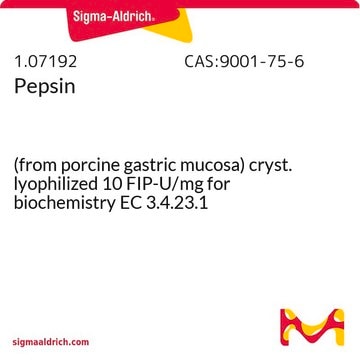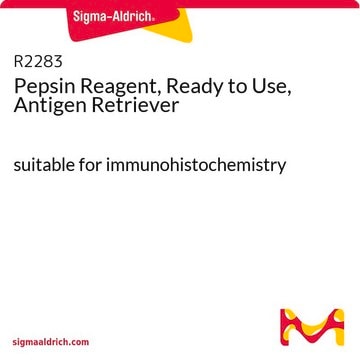10108057001
Roche
Pepsin
lyophilized (salt-free), ~2500 units/mg protein (At 37 °C with hemoglobin as the substrate. One unit is the enzyme activity which liberates the amount of Tyr producing an increase in the absorbance of 0.001/minute at 280 nm.)
Sinónimos:
pepsin
About This Item
Productos recomendados
origen biológico
pig gastric mucosa
Nivel de calidad
Formulario
lyophilized (salt-free)
actividad específica
~2500 units/mg protein
envase
pkg of 1 g
fabricante / nombre comercial
Roche
pH óptimo
1.8-2.2
Condiciones de envío
wet ice
temp. de almacenamiento
2-8°C
Categorías relacionadas
Descripción general
Especificidad
Aplicación
Nota de preparación
Storage conditions (working solution): A pepsin solution is stable at 2 to 8 °C, at least for one week, at neutral pH and under germfree conditions. Frozen aliquots of the enzyme solution are expected to be more stable.
A stock solution in 10 mM HCl (5-10 mg/ml) should be stable for at least one week at 2 to 8 °C, too. Storage light protected, tightly closed.
A short (2 minutes) incubation at 40 °C has negligible effect on the activity of lyophilized pepsin or pepsin in solution.
Nota de análisis
Otras notas
Palabra de señalización
Danger
Frases de peligro
Consejos de prudencia
Clasificaciones de peligro
Eye Irrit. 2 - Resp. Sens. 1 - Skin Irrit. 2 - STOT SE 3
Órganos de actuación
Respiratory system
Código de clase de almacenamiento
11 - Combustible Solids
Clase de riesgo para el agua (WGK)
WGK 1
Punto de inflamabilidad (°F)
Not applicable
Punto de inflamabilidad (°C)
Not applicable
Elija entre una de las versiones más recientes:
¿Ya tiene este producto?
Encuentre la documentación para los productos que ha comprado recientemente en la Biblioteca de documentos.
Los clientes también vieron
Nuestro equipo de científicos tiene experiencia en todas las áreas de investigación: Ciencias de la vida, Ciencia de los materiales, Síntesis química, Cromatografía, Analítica y muchas otras.
Póngase en contacto con el Servicio técnico










